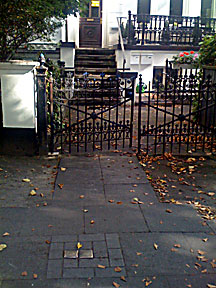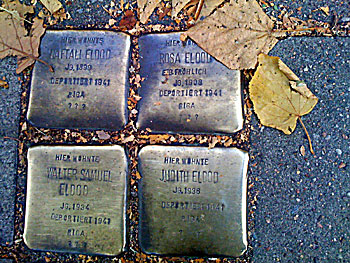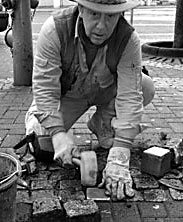|
Everywhere a Guest, Nowhere At Home: A New Vision of Israel and Palestine, is the title of a new book about the very human capacity not to see what is in front of one's eyes. The author, Kim Chernin, patiently, relentlessly, pursues the process of fighting her own blindness. What is it in us, she asks, that sticks to denial, rearranges the painful image, fiercely holds on to amnesia when the knowledge is already there? In her book the invisible knowledge comes into view like the snaps of a camera. She arrives at the unthinkable thought: could it be that the same paradoxical not-seeing, not-knowing has taken hold in Israel that we remember only too well from Germany, where every good citizen swore not to have known what was happening right in front of their eyes?
Sometimes, seeing happens by chance. You stumble right into it. A book falls open in your hands, you overhear a conversation, you find yourself outside your comfort zone and suddenly freeze: for one moment your eyes are open.
It happened to me last month on a trip to Germany, the home country where l never feel "at home". I was walking through the university quarter of Hamburg, looking at the remnants of my past in this city. At first I saw nothing. I was looking at the buildings in a beautiful old residential street where I used to occupy a student flat. I tried to remember the house number when I tripped over it: a series of small, strangely colored cobbles in the sidewalk pavement in front of an entryway.  The size of a kitchen tile, they stood out from the grey cement by their golden-grey metal sheen and the square mosaic frame of cement cobbles placed around them. A text was engraved in the metal of each cobble stone: The size of a kitchen tile, they stood out from the grey cement by their golden-grey metal sheen and the square mosaic frame of cement cobbles placed around them. A text was engraved in the metal of each cobble stone:
"Here lived Olga Misch, born Heller. Year of birth 1880. Deported in 1942. Theresienstadt. Murdered on 7/8/ 1942." At the next entryway, "Here lived Joseph London, born 1893. Arrested 1937. 1938 KZ Buchenwald. Murdered Oct. 2, 1940".
A few doors down, eight of the strange monosyllabic "Haikus" of death – two whole families carted away, murdered or, as the three question marks at the bottom convey: disappeared. Destiny unknown. A block down the street, four of them — a family with two children, all deported to Riga in 1941, no further knowledge available. Three question marks. Across the street, members of another family: one deported and disappeared; one deported to Theresienstadt in 1942, murdered in 1943; the third one deported to Auschwitz, destiny unknown. "Here lived Julius Hirschfeldt. Born 1864. Erniedrigt/ Entrechtet. Flucht in den Tod." "Humiliated. Deprived of his rights. Flight into his own death."
 |
I didn't believe my eyes. It took me a moment for the knowledge to appear in my memory: these were the famous Stolpersteine, the "Stumbling Stones" of Germany that I had heard about from my family and German friends. I remember my ambivalent feelings, shock and excitement, when I first learned about this new German way of trying not to forget, decades after the massive collective forgetting.
But seeing the stones was a different kind of shock. A new disbelief. A look up at the building: which apartment? Which one of the many windows? When did it happen? At dawn? In the dead of night? The dead of silence? In one part of the street, the year is always 1941. Was it the same day, the same night, the same razzia? Did the SS or Gestapo go street by street, block by block, quarter by quarter? Did the neighbors stand behind their curtains and watch?
They are watching now, as I bend down on the sidewalk to read, as I take out my I-phone, bend down again to take a photo, step back to take in and photograph the whole house where the unthinkable happened. What is it like to live in this house, perhaps in the same apartment where Julius Hirschfeldt used to live?
To cross this threshold of undeniable history, undeniable terror and pain, each day? How do the kids react who notice anything shiny on the ground in an instant?
In a particularly baroque building, a woman on her balcony stares down at me; another woman is visible behind a window. I look back at them; there is no sign of approval or disapproval, just a silent stare. Being watched. What am I for them? A Nestbeschmutzer – like the person who placed the Stolperstein at their doorstep? "A bird shitting in its own nest" was the label used after the war for anybody who dared criticize Germany and the Germans. I suspect at best they take me for a stranger, a hostile tourist perhaps. They would not easily think of me as just another German, a guest in her own country.
A middle-aged man approaches the same house on a bike. He greets me with a friendly smile as he pushes his bike past me into the entryway. It seems obvious to him that I am doing what I am doing, no need to question or comment.
I decide to approach a mailman in another street. "You know this area," I begin. "Are there any houses here with Stumbling Stones?" He stares at me with a frown. He is my age, the post-War age. There is a pause. He seems to try and read my intent or weigh his reply. "Well," he says, "all you need is walk up and down this street. You'll find them."
I find them everywhere. People pass me as I stand in the middle of the sidewalk, contemplating both the past and the present. There is a frozen, fearful expression in many faces that meet my gaze or avoid me. These are beautiful bourgeois buildings, this is a privileged area, a stone's throw from the tall university building called "Philosophers Tower." What is it like to live here now, in a house that wears the letter J of shame? When I come across the mailman again, he has made up his mind. His face lights up. He asks: "Did you find them?" "Oh yes," I say. "It's sad… ." "Sad indeed," he nods and we exchange another look, clearly on the same side by now.
It's easy to imagine that this extraordinary decision of city planning did not go down without controversy in Germany. The moment I get to my computer I research the question. A whole city declined to participate. To nobody's surprise it was Munich, where the career of the Thousand-Year Reich's Führer famously took off. More or less surprising was the pious explanation given: it would not be the proper thing to step on the Jews in this way. The controversy, started in the early nineties, echoed through the Jewish world. Charlotte Knoblauch, President of the German Central Council of Jews, was among the first to express horror at the idea — Jewish victims being once again exposed to German boots —, but the Vice President, Salomon Korn, vigorously defended the unusual street memorial and the artist who created it.
The artist, Gunter Demnig, a member of the post-war generation, placed the first stones in order to give a name back to the Nazi victims who had been degraded to numbers in the concentration camps.  The decisive moment of outrage, for him, had come at the unveiling of some other Holocaust memorial when he heard an elderly German woman claim there had been no Holocaust victims living in her area. When he started his mission he decided to include all people persecuted by the Third Reich: Jews, gypsies, homosexuals, Jehovah's Witnesses as well as victims of euthanasia and political dissent. Having to bend down in order to read the engraved texts, in his eyes, is a symbolic bow before the victims. And the more feet walk over the stones on city streets, the brighter the brass plates shine from the unintentional polish of traffic. The artist counters the danger of stumbling accidents caused by the slightly raised stones with a quote from a schoolboy: "No, no, you don't trip over them and fall, you trip with your head and heart!" The decisive moment of outrage, for him, had come at the unveiling of some other Holocaust memorial when he heard an elderly German woman claim there had been no Holocaust victims living in her area. When he started his mission he decided to include all people persecuted by the Third Reich: Jews, gypsies, homosexuals, Jehovah's Witnesses as well as victims of euthanasia and political dissent. Having to bend down in order to read the engraved texts, in his eyes, is a symbolic bow before the victims. And the more feet walk over the stones on city streets, the brighter the brass plates shine from the unintentional polish of traffic. The artist counters the danger of stumbling accidents caused by the slightly raised stones with a quote from a schoolboy: "No, no, you don't trip over them and fall, you trip with your head and heart!"
This kind of "desired stumbling" was not only decried as a health hazard by its adversaries, German house owners also feared the hazard of losses in property values. Cities argued that there were already enough museums and monuments to the cause, that Jews had received enough money and attention, that Germany ought to rather think of the victims of Allied bombing raids, etc. Again and again, a part of the public accused the artist as a schemer and money-maker on the back of Nazi victims. When Demnig started his "urban guerilla" actions of placing Stumbling Stones in front of residences where victims had lived, the city of Munich promptly tore the stones out again. But most other German cities legalized and supported the action which quickly snowballed. Placing Stumbling Stones has turned into a large democratic movement that lets anybody participate. All one has to do is sponsor a Stolperstein for 95-Euro a piece. In 1995, the German government sanctioned Demnig's political art action by awarding him the highest civil order of the state. Innumerable other awards for civil courage followed. Slowly but steadily the movement has swept over the borders to reach Austria, Holland, Poland and other countries up to the Ukraine. In Germany alone, some 20 000 street memorials have been set into the pavement up to this date.
Controversy and ambivalence are the inheritance of German Vergangenheitsbewältigung, a tongue-breaker as well as mind-breaker, impossible to translate. Tidy up, file away, digest, work through the past – it's all of these. Interestingly, the guilty German democracy has done an amazing job of dealing with and not forgetting its own abomination. No other country involved in the Second World War has done anything remotely as effective or honest. One could talk about the equivalent to the South African Truth and Reconciliation effort – with the difference that the proverbially thorough Germans left hardly any victims to reconcile with. They had to reconcile with themselves, a tricky task. A task that never seems done. There are never enough stumble stones, it seems to me, to overcome the deep ambivalence of being German. Have they really changed? It would be nice to believe it, but my ambivalence resists.
I have to take a number of trains, always a loaded affair in this country. Trains and train tracks have been the most potent visible symbol of the Final Solution. At the same time, the great metropolitan train stations of my youth, like the one in Hamburg, with its loudspeaker announcements of destinations like Paris, Barcelona, Rome, Vienna, Prague, held the promise of the ultimate exit, the way out, the chosen exile from Germany even long after the Holocaust, in the years of my coming of age. It says something about change that nowadays, the once impeccable order of German train traffic resembles improvised chaos. Trains are fast; you can cross the entire country in a few hours and everyone nowadays does. The crowded stations, trains, platforms have become a new nightmare of masses moving at any time, any day.
I arrive back from my Stolperstein walk to journey on to Frankfurt. Crowds of rowdy youth seem to haunt every big station; this time the hall reverberates with howling, roaring male voices. Throngs of young men press onto the stairs to a platform, shouting. It's the platform of the trains to Munich. Is this about the Oktoberfest? I do not like those sounds; I notice some death heads on T-Shirts; beer bottles swinging in hands. I can't hear the mass roaring of male voices without hearing Sieg Heil! I am instinctively relieved when I notice countless policemen positioned everywhere around the platform, in fact, around the entire station. They look inconspicuous, with baseball caps and sports bags. You could mistake them for the travelers until you notice the police lapels and taser guns at their belts. Like with the stones: once you notice them, you see them everywhere.
I ask an officer, a sweet-faced guy looking barely eighteen. He explains that this is a train to Bremen, to a soccer event. When the roaring crowd has finally squeezed into the train, the police officers squeeze in just before the doors close. My relief changes back to ambivalence. Hundreds of policemen for one soccer train?
My train to the Frankfurt airport does not seem to need a police contingent. On this ordinary weekday noon the train is packed so that people can't get to their reserved seats. There is an atmosphere of stuck impatience, of tiny kids trapped between suitcases and backpacks. Friends press together into one seat; people stand in the aisles, sit on the floor everywhere. Reports about delays, missed connections are exchanged. After an hour, the train stops shortly before a station. A male voice explains over the speakers that we are two minutes early and have to wait, alas, to enter the station. People laugh and crack jokes. This seems to be a déjà vu. It doesn't take long and we stop again, this time in the middle of nowhere. The voice announces a technical defect. More laughter, a number of sighs. Twenty minutes later, "we" are still working on the problem, but the voice encourages us to "durchhalten", to endure with optimism. The compartment erupts in merriment and applause about the choice of words. But now more anxious phone calls are being made. Some travelers are raising their voices, cursing. Strangers start complaining to each other. The tension is rising.
I wonder what it would be like to be trapped here, in a train, in an apartment, a city, a country with closed borders, a police state. I feel what I feel every time I leave Germany. Relief that I will soon be on an airplane crossing the Atlantic. Adieu, Heimat. As long as there is a way out.
|

